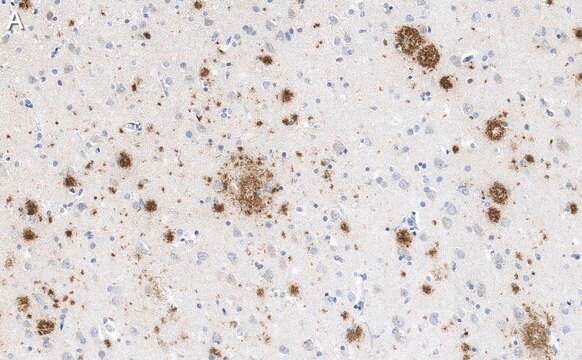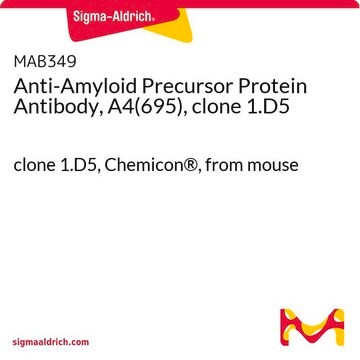MABN254
Anti-Beta (β)-Amyloid antibody
mouse monoclonal, 6C3
동의어(들):
Amyloid beta A4 protein, ABPP, APPI, APP, Alzheimer′s disease amyloid protein, cerebral vascular amyloid peptide, CVAP, PreA4, Protease nexin-II, PN-II
About This Item
추천 제품
제품명
Anti-amyloid beta peptide (MOAB-2), pan Antibody, clone 6C3, clone 6C3, from mouse
생물학적 소스
mouse
Quality Level
항체 형태
purified immunoglobulin
항체 생산 유형
primary antibodies
클론
6C3, monoclonal
종 반응성
human
기술
dot blot: suitable
immunofluorescence: suitable
immunohistochemistry: suitable (paraffin)
immunoprecipitation (IP): suitable
western blot: suitable
NCBI 수납 번호
UniProt 수납 번호
배송 상태
wet ice
타겟 번역 후 변형
unmodified
유전자 정보
human ... APP(351)
일반 설명
특이성
면역원
애플리케이션
Western Blot Analysis: A representative lot was used by an independent laboratory in unaggregated forms of Aß42 and Aß40. (Youmans, K.L., et al. (2012). Mol Neurodegener. 7;8.)
Dot Blot Analysis: Serial Aβ40 and Aβ42 dilutions were probed with MOAB-2 or 6E10 by an independent laboratory. (Youmans, K.L., et al. (2012). Mol Neurodegener. 7;8.)
Immunoprecipitationt Analysis: A representative lot was used by an independent laboratory in unaggregated and fibrillar forms of Aß42 and Aß40. (Youmans, K.L., et al. (2012). Mol Neurodegener. 7;8.)
Neuroscience
Neurodegenerative Diseases
품질
Immunohistochemistry Analysis: A 1:1,000 dilution of this antibody detected Amyloid Beta Peptide in human Alzheimer′s diseased brain tissue.
표적 설명
물리적 형태
저장 및 안정성
분석 메모
Alzheimer′s diseased human brain tissue.
기타 정보
면책조항
적합한 제품을 찾을 수 없으신가요?
당사의 제품 선택기 도구.을(를) 시도해 보세요.
Storage Class Code
12 - Non Combustible Liquids
WGK
WGK 1
Flash Point (°F)
Not applicable
Flash Point (°C)
Not applicable
시험 성적서(COA)
제품의 로트/배치 번호를 입력하여 시험 성적서(COA)을 검색하십시오. 로트 및 배치 번호는 제품 라벨에 있는 ‘로트’ 또는 ‘배치’라는 용어 뒤에서 찾을 수 있습니다.
자사의 과학자팀은 생명 과학, 재료 과학, 화학 합성, 크로마토그래피, 분석 및 기타 많은 영역을 포함한 모든 과학 분야에 경험이 있습니다..
고객지원팀으로 연락바랍니다.








